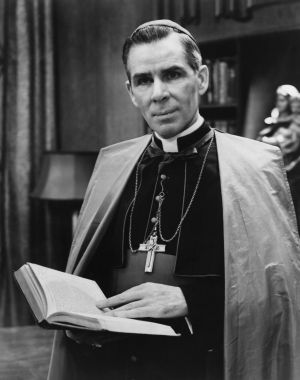WASHINGTON (CNS) — On a Tuesday night in 1953, roughly 25 million people in the United States gathered around their television to watch a program featuring that year’s Emmy winner for “Most Outstanding Television Personality.”
However, instead of tuning in to a slickly produced program made in Hollywood, these people turned on their sets to see a priest in full cassock, standing in front of a chalkboard.
Few members of the American Catholic Church, especially in the 20th century, are as quickly recognized as Archbishop Fulton J. Sheen. In honor of the 75th anniversary of the first radio broadcast of his NBC program, “The Catholic Hour,” and to draw attention to his sainthood cause, The Catholic University of America sponsored a number of events April 13-17.
The events included an April 13 panel discussion on “Media and the New Evangelization,” of which Archbishop Sheen has been called a pioneer; as well as memorial Mass and holy hour and the dedication of a memorial classroom in his honor.
In a video produced by the university highlighting Archbishop Sheen’s time spent studying and lecturing there, university president John Garvey said that his life and example are “a reminder to all of us that we’re all called to be saints.”
[hotblock]
According to the university website http://fulton-sheen.cua.edu, the archbishop’s “whole-hearted embrace of modern means of communication gave him access to millions of American homes, and made him arguable the most influential American Catholic of the 20th century and a pioneer of the new evangelization.”
Last September, his sainthood was suspended indefinitely, when the Archdiocese of New York denied a request from Bishop Daniel R. Jenky of Peoria, Illinois, president of the Archbishop Sheen Foundation, to move the archbishop’s body to Peoria. The archbishop was born in the Peoria Diocese in 1895; he died in New York in 1979.
Dominican Sister Maria Frassati Jakupcak, co-chair of the university’s Fulton Sheen Legacy Committee, told Catholic News Service the situation is really nothing new.
“There’s a dispute over who gets Sheen’s body,” explained Sister Maria. “It’s very medieval. This is something that happened quite often in the medieval church: disputes over saints’ relics.”
Despite the current stay on the beatification process, however, the first approved miracle necessary for his beatification has been already cleared two of the three stages necessary for Archbishop Sheen to be declared “blessed.”
“The miracle has to be approved three times, first by a series of medical experts, then by a panel of theologians and then by the Holy Father,” said Sister Maria. “Last summer, Sheen’s miracle was approved by the medical experts and team of theologians.”
She described the miracle pending approval: It involved a baby, a boy, who was delivered still born but who survived after prayers for the intercession of Archbishop Sheen. The child, James Fulton Engstrom, is now 3 years old and developing normally.
“He was examined three different times by different medical experts and showed no signs of life for 61 minutes,” Sister Maria said. “The mother … was praying to (Sheen) the whole time. As the doctors were writing the death certificate, he started breathing.”
Andrea Ambrosi of Rome, postulator of the Sheen cause, has said the suspension is temporary.
Archbishop Sheen was declared “venerable” by Pope Benedict XVI in 2012, meaning he lived a life of heroic virtues. In general two miracles are needed for sainthood — one for beatification and the second for canonization.
In addition to various events honoring the archbishop’s memory, Catholic University — where he arrived as a student in 1920 and where he taught from 1926 to 1950 — also organized exhibits on his life, legacy and books in its student center and library to be on display until April 17.
PREVIOUS: Acts of Apostles tells of people, events in Christianity’s early history
NEXT: Speaker ties Year of Mercy to late pope’s devotion to Divine Mercy




Share this story